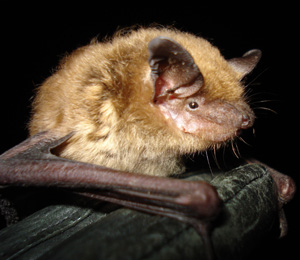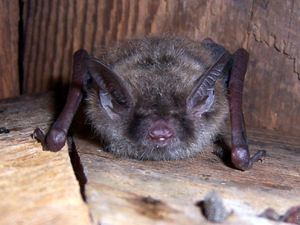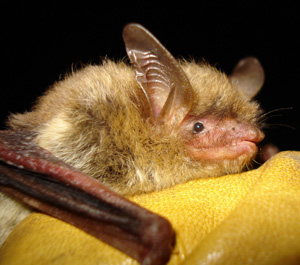Nature Notes: Helping Wisconsin Bats
By Anna Foster, Program Director
Imagine walking down a boardwalk by the light of the moon, feeling the cool breeze from Lake Michigan through the boreal forest, and hearing the distant call of a Barred owl marking its territory.
Sanctuary Night Hikes are a popular program because they are completely immersive and require participants to engage with all their senses.
Our initial connection with the forest is through our senses. Smells, sounds, and textures are all incorporated into our sense of place. In fact, there is no better way to understand the forest than to observe it.
Whether you’re participating in a Night Hike, a Sanctuary Guided Hike, a workshop, or simply taking a solitary walk on the trails, experiencing the Sanctuary is, by nature, sensorial. You are more likely to remember how to identify a white pine tree if you can see the tree, feel the bark, and count the bunches of pine needles. Programs also allow Ridges staff to teach people about organisms that they wouldn’t be likely to learn on their own.
Perhaps the most controversial portion of our Night Hikes is when we observe bats swooping over the swales. Participants often murmur or cringe in disgust. I understand their reaction. Bats have a strong connotation with disease – particularly rabies. However, bats play a critical role in our ecosystems. They eat flying insects, like mosquitoes and other agricultural and woodland pests. They are also responsible for reducing diseases such as West Nile Virus (1) and help Wisconsin farmers produce about 500-700 million dollars in crops every year through pest prevention (2).



Pictured Left to Right: big brown bat, little brown bat, northern long-eared bat
Wisconsin is home to eight species of bats: Cave bats include the big brown bat, the little brown bat, the northern long-eared bat, and the tricolored bat. These bats spend winters hibernating in cave sites called hibernacula. Tree bats include the silver-haired bat, the eastern red bat, the hoary bat, and the evening bat. These bats spend their summers in Wisconsin, migrating south in the winter months (3).
The Ridges hosts bat programs and workshops to spread awareness of Wisconsin bat species and White Nose Syndrome. The acquisition of an acoustic monitor in 2023 allowed us to conduct bat surveys during the 2024 summer season. On the evening of June 18th, Ridges staff unexpectedly captured twelve recordings of the northern long-eared bat in the Sanctuary!
Unfortunately, the northern long-eared bat is rarely recorded in the state of Wisconsin and is federally endangered and listed as “threatened” in the state (4). Northern long-eared bat populations have been severely impacted by white-nose syndrome, a fungal disease that has spread across the eastern and central United States over the past 17 years. In some locations, hibernacula have lost up to 95% of their populations (5). In Door County, white-nose syndrome has killed over 90% of cave bats. Horseshoe Bay Cave bat populations dropped from 1,100 bats in 2015 to 24 bats in 2019. Luckily, some populations have survived (6).
While humans cannot catch white-nose syndrome, they can spread it. Thoroughly decontaminating clothing or material worn in a cave can help prevent disease from spreading between cave environments. In fact, decontamination is required for any person entering or exiting caves in Wisconsin to help prevent the spread of the disease.
There are additional ways to help Wisconsin’s bats. The Ridges holds several programs in October to bring awareness to Wisconsin bat species, including a Bat House Workshop. Bat houses can be important summer roost sites and provide shelter for bats in our area. During the workshop, Ridges staff provide materials and instructions to build a bat house. Participants also receive instructions for installing and maintaining their bat houses. If you can’t make the Bat House Workshop, the Wisconsin DNR has detailed instructions for building bat houses.
Protecting habitat is another critical component to helping to restore bat populations in Wisconsin. Bats rely on healthy wetlands and forests for food and shelter throughout the summer months. Ensuring that bats have access to these resources will help populations recover from white-nose syndrome (4). The 1,700 acres of the Sanctuary provides both wooded habitat for bat roosts and wetlands for hunting grounds. Other protected places in the county also provide critical habitat for bat populations.
Lastly, education about Wisconsin’s bat species is paramount to their recovery. We share information about bats on Night Hikes and in other programs to dispel prevalent misconceptions about them, and to teach people how important they are to ecosystems like the boreal forest. At the very least, we hope people smile rather than cringe when they see bats flying above them in the night sky!
Bat Facts
1. Bats can live a long time for their size. The oldest recorded bat in Wisconsin was at least 32 years old!
2, Bats are the only mammals that have adapted to true flight.
3. Insectivorous bats use clicks to echolocate. Their clicks are ultrasonic, meaning they are outside the range of human hearing.
4. A single little brown bat can eat 1,000 mosquito-sized insects in an hour.
5. Northern long-eared bats are especially good at hunting moths! Moths have a hard time hearing the high-frequency calls that northern long-eared bats produce.
Photo Credits: big brown bat, Dave Redell via eekwi.org; little brown bat, WDNR Staff via apps.dnr.wi.gov; northern long-eared bat, Dave Redell via eekwi.org.
Sources Cited:
- “Saving Wisconsin’s Bats | Wisconsin DNR.” Accessed August 28, 2024. https://dnr.wisconsin.gov/topic/WildlifeHabitat/Bats.
- “About Bats – WI Bat Program.” Accessed August 28, 2024. https://wiatri.net/inventory/bats/aboutBats/WIBats.cfm.
- “About Bats – WI Bat Program.” Accessed August 28, 2024. https://wiatri.net/inventory/bats/aboutBats/WIBats.cfm.
- “Northern Long-Eared Bat (Myotis Septentrionalis).” Accessed August 30, 2024. https://apps.dnr.wi.gov/biodiversity/Home/detail/animals/6731.
- “White-Nose Syndrome.” Accessed August 28, 2024. https://www.whitenosesyndrome.org/static-page/what-is-white-nose-syndrome.
- Sterrett, Craig. “Bat Population Up Slightly in Door County Cave.” Peninsula Pulse, May 5, 2022, sec. Green Page. https://doorcountypulse.com/bat-population-up-slightly-in-door-county-cave/.
Additional Sources:
Maness, Carson. “Researchers Record Oldest Little Brown Bat Ever.” The Wildlife Society (blog), March 10, 2015. https://wildlife.org/researchers-record-oldest-little-brown-bat-ever/.
“Northern Long-Eared Bat (Myotis Septentrionalis) | U.S. Fish & Wildlife Service.” Accessed August 30, 2024. https://www.fws.gov/species/northern-long-eared-bat-myotis-septentrionalis.
Schmidt, Amanda. “Bat Fact Sheet | Blog | Nature | PBS.” Nature, July 6, 2021. https://www.pbs.org/wnet/nature/blog/bat-fact-sheet/.
Wisconsin Department of Natural Resources. “Echolocator.” Echolocator, May 2023. chrome-extension://efaidnbmnnnibpcajpcglclefindmkaj/https://wiatri.net/inventory/bats/news/pdf/2023MayEcholocator.pdf.
Ridges Bat Programs
Bat Chats Guided Night Hike
Friday, October 11th, 6:00 pm-8:00 pm
Let’s chat about Wisconsin bats! Join Ridges staff on a hike through the Sanctuary, stopping to learn about the unique adaptations and life cycle of bats. Stop along the way to capture bats on an acoustic monitor. Suitable for ages 14 & up.
Location: Cook-Albert Fuller Nature Center
Fee: Public $15 | Member $12 | 16 & under $7
Get to Know Wisconsin’s Bats Presentation
Friday, October 18, 2:00 pm-3:30 pm
Curious about Wisconsin’s bats? Want to know more about white-nose syndrome? Join us for a presentation all about Wisconsin bat species, white-nose syndrome, and current population data.
Location: Cook-Albert Fuller Nature Center
Fee: Public $8 | Member $5 | 12 & Under Free
Friday, October 18, 3:30 pm
Build your own bat house to hang on your property! We’ll help you assemble your own bat house and give you instructions on hanging and maintenance so you can provide important shelter for native bat species.
Location: Ridges Workshop
Fee: Public $45 | Member $40